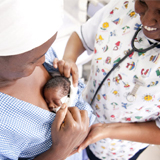
Every year, more than four million babies less than one month of age die, most of them during the first week of life. About 20% of these deaths occur among low birth weight (LBW) and preterm
babies.
In Nigeria about 14,584 babies are born every day. For every 1,000 babies born alive. 48 die in the neonatal period i.e. the first 28 days of life. In other words, 1 in 21 babies dies during the first month of life i.e. 695 babies are dying every day in some parts of Nigeria. In addition, about 448 babies are dying inside their mother’s wombs or born dead daily. Most of these deaths are a consequence of the poor health and nutritional status of the mother coupled with inadequate care before, during, and after childbirth. Those babies who survive are at risk for poor growth and increased rates of illness from infectious diseases in infancy and childhood. They also may have compromised cognitive, motor, and behavioral development.
The causes of LBW are many and complex. The main problems of a low birth weight baby are low body temperature, breathing and feeding problems. LBW babies require special attention if they are to survive, particularly with regard to warmth, feeding, hygiene practices, and prompt identification and treatment of complications.
Kangaroo Mother Care (KMC) was first started in 1979 in Bogota, Colombia in response to shortages of manpower and congestion in their neonatal nursery i.e. they didn’t have enough incubators to cope with the high numbers of babies born prematurely. Just like in Colombia, Nigeria also has challenges of manpower and adequate numbers of incubators in its health facilities and thus the need for KMC. This method of care emulates the Kangaroo animal which is found in Australia. The baby kangaroo (Joey) is born premature and gets into its mothers pouch where it will be kept warm and exclusively breast fed for several months until it is big enough to survive outside. Similarly, human babies born prematurely also need warmth, exclusive breast feeding and love. Kangaroo Mother Care copies this efficient method, where the baby is kept “skin-to-skin” with its mother. KMC addresses these problems as the baby is easily
kept warm, easily breast fed and any breathing problems can be easily identified.
Kangaroo mother care (KMC) is therefore a simple, cost-effective approach that can meet many of the basic needs of these newborns.
It is against this background that this KMC training manual has been put together to address the dearth in the knowledge and skills required to effectively manage these babies in a cost-effective but yet high quality manner. It is my sincere hope that with the effective usage of this manual, especially at the lower levels of health care, there will be a reduction in neonatal mortality and that it will contribute to Nigeria’s achievement of achieving the fourth millennium development goal.
Please download the full resource to view the guide.